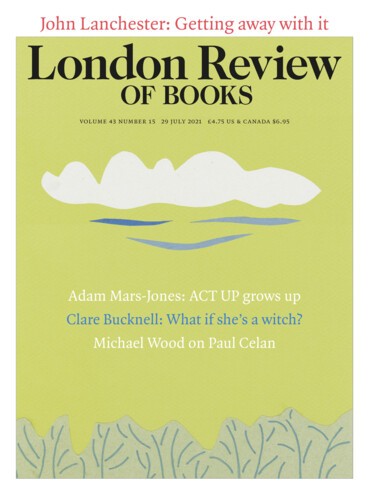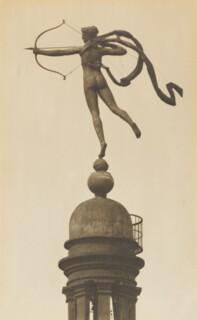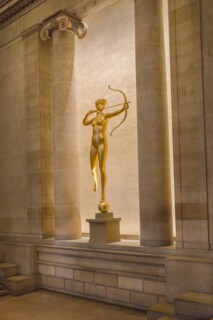For a short while the highest point of the New York skyline was marked by a girl standing on tiptoe. At night she was also the brightest point, the focus of 66 incandescent lamps and ten spotlights, at a time when there was little electric light in the city. During the day, the sun detonated her gilded surface and she ‘flashed against a green-blue sky’, as Willa Cather described it in My Mortal Enemy.
She was no girl but a thirteen-foot-high goddess: Diana, the hunter, holding a bow and arrow, the string tautly drawn. The figure was commissioned by the architect Stanford White for his redesigned Madison Square Garden. It was the largest amphitheatre in America, the setting for sporting events, dog shows, political conventions and all-round spectaculars. White topped the building with a lavish tower and asked the sculptor Augustus Saint-Gaudens to create a weathervane to crown it: he needed the extra height to trump a skyscraper that had recently been built nearby. Saint-Gaudens’s first attempt, installed in 1891, was eighteen feet tall and too cumbersome to turn in the wind, so he replaced it in 1893 with a version that was shorter, lighter and more lithe. Diana was at once intensely visible and way out of reach. At night, according to a visitors’ guide, ‘the graceful lines of the tower are half-disclosed and half-suggested, and Diana reveals herself to us in the radiance of electric light.’
When the first Diana was installed, White marked the occasion with a festival of light: 6600 electric bulbs were strung along Madison Square Garden and another 1400 on the tower. Unlike the goddess in her dappled shade, this Diana was bathed in the brilliance of ten arc lights. How could anyone have seen anything? Actaeon makes his way towards Diana because he too has been dazzled. The day is at its brightest. ‘Midday had contracted every shadow’ and he wants to rest after a morning’s hunting. He ‘strays with aimless steps through the strange wood’. If he is drawn to anything it is to a gentle intensification of light, the suggestion of a clearing or water. When he approaches the naked goddess, she is bathing in a pool, surrounded by nymphs who immediately move to conceal her. In Ovid’s version, there is no moment when Actaeon actually catches sight of Diana. Instead he is described as being seen to be about to see her: ‘the naked nymphs, seeing a man’s face’. He becomes the subject of a desire he barely registers and is torn apart by it, turned into a stag and killed by his own hounds.
White’s Diana was designed for distance. The emphatic alignment of her gaze, her bow and arrow and flatly angled arms reflect the need to be clear about the direction in which she’s facing (she was a weathervane, after all). She is hollow, made of beaten copper sheets held together by invisible rivets and, though supported inside by an iron armature, light enough to turn in the wind. Her pose is conventional but precarious: standing on tiptoe on one leg, balanced on a sphere. She has the efficient modern body of the tennis-playing tomboy. Her toes splay as she steadies herself, her knuckles flare as they grip the string of her drawn bow. The way her raised leg turns in slightly, the attention given to her knees, wrists and elbows, suggest the close study of a model and the desire for her to look not only divine but real. ‘This flowing, gracile figure, its curves deliciously melting as it turns its outlines in the wind and sun, wins, but it does not command,’ the International Studio pronounced in 1908. ‘It has not the compelling force of triumphant beauty. It is close to the model.’ She looked too real to be thought of as the real thing.
I first came across her in an atrium by a café in the Metropolitan Museum of Art, although the Diana I saw was a copy taken later from a test cast. Less than half the size of the final version, this one is made from gilded bronze rather than copper. She lacks impact; somehow the eye knows that this is a copy of a model for a study of a woman. The actual model for Diana, Julia Baird, was seventeen. The youngest of seven children with a widowed mother, she had started earning a living as soon as she could and was already well known among artists as a sitter. Saint-Gaudens only used Baird for Diana’s body. The head was modelled on that of his mistress, Davida Clarke. It’s as though the perfect woman, by definition, could not exist. Saint-Gaudens’s life, too, was made up of separate parts: the louche world of Madison Square Garden, and the sombre but highly polished world of home. In a portrait of Saint-Gaudens’s wife and son painted by Sargent, dark clothes dissolve into dark furniture. The boy’s expression is one of submission. He seems to be held in place by his shoes’ excessive gleam; his hands are limp in his lap. His mother sits behind him, reading. It’s a long way from the apartment White used for seducing adolescent girls, with its green velvet swing and ‘mirror room’.
Diana didn’t survive the city’s scrutiny. Her drapery was quickly lost and her surfaces corroded. An attempt was made to turn her to more practical use when in 1924 experiments were done to see if she would make a good radio aerial. In 1900, Saint-Gaudens was diagnosed with cancer and moved to the country. Six years later, White was murdered at Madison Square Garden by the deranged husband of Evelyn Nesbit, whom White had raped when she was sixteen, around the same age as Julia Baird. Madison Square Garden itself ran at a loss until it went bankrupt in 1925 and passed into the hands of the New York Insurance Company, which demolished the building and erected a skyscraper in its place. The city was starting to rise, and there were new landmarks and new amazements. As the Evening News had observed in 1911, ‘the people stare from one thing to another … without so much as a wink at poor little Diana.’
She languished in a Brooklyn warehouse for seven years, where, placed face down, she began to collapse under her own weight. Intended for the sky, she was ungainly on the ground. Plans to relocate her on ‘a suitable pedestal’ at New York University came to nothing and after six years of negotiations, D.F. Kingsley, an employee of the insurance company, issued an ultimatum: ‘I have exhausted myself in efforts to have her suitably placed. They have all come to nothing. I don’t want to have her dumped, destroyed, melted, or whatever may happen, without giving you a chance to say a final word.
The university failed to find a solution, so the exasperated insurance company agreed to give Diana to the Philadelphia Museum of Art, which paid for her restoration. The emblem of the Gilded Age, of a young and modern city, who blared brightly from an impossible height, had weathered badly. ‘She was gold when she went up, she was grey when she came down.’ Even when installed in Philadelphia, her authenticity came into question. An archery expert was one of many who remarked that ‘undoubtedly the young lady would be injured were she to shoot as posed.’
In 2013 she was regilded, a process that took five months and 180 square feet of gold leaf. Even though she was refinished according to Saint-Gaudens’s original instructions, with ‘matting and toning’ to make her ‘glow not glare’, she is shocking, once again a brash insouciant advertisement for high living. She stands in the museum’s Great Stair Hall. The walls, floors and stairs are thundercloud grey and she appears as if suspended, as harsh and captivating as a lightning bolt. As I got closer, I saw that what looked like modelling was shading. She is defined as if by a spray tan. The actual lines of her arms and legs are far cruder than they appear. You can see that her hollow heel is impaled on a spike that fixes her to the ball on which she stands. I took photographs and, looking at them later, saw once again a finely moulded and graceful figure. How apt that she is so photogenic. Revised, reproduced, brought down to earth and now on a ‘suitable pedestal’ at last, she brings into the muted indoor space a supernatural wildness, stepping out, as Cather wrote, ‘freely and fearlessly into the grey air’.
Send Letters To:
The Editor
London Review of Books,
28 Little Russell Street
London, WC1A 2HN
letters@lrb.co.uk
Please include name, address, and a telephone number.



